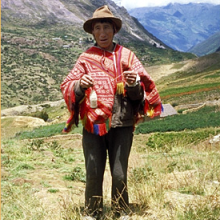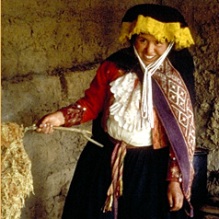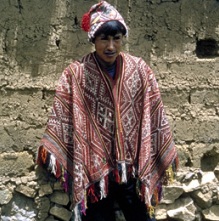learn how
Traditional Weaver - Nilda Callañaupa Alvarez - Traditional Clothing

Even in traditional areas, today's clothing styles are a fusion of indigenous hand-woven, uncut cloth and Western tailored garments. In most cases modern clothes are combined with traditional attire, such as in Aacha Alta, where the men wear commercially-made trousers together with hand-woven ponchos (see left).
Traditional highland attire, the indigenous fashions worn since colonial times, includes garments such as trousers and pleated skirts which were introduced by the Spanish. The components of a traditional outfit can be found with variations at all of the villages Nilda works with.

Women's clothing
This young woman is from Chahuaytiri. She is wearing her traditional clothes. She wears a skirt of wool with a woven border (golon). Around her shoulders is a handwoven wool mantle or llijlla which is pinned under her chin. She wears a blouse and a jacket of wool with embroidery, the shape of which is derived from a Spanish tailored garment. Her hat is typical of her community and she also wears a belt around her waist. Click on the different pieces of clothing she's wearing to see examples from other communities.

Men's clothing
This young man is from Chahuaytiri. He is wearing his traditional clothes. He wears black handspun, handwoven wool trousers and shirt, the shirt similar to the unkhu or knee length shirt worn in Inka times. His poncho is also handwoven wool featuring the designs of his community, and is typical of ponchos worn throughout the Andes today.

The poncho is among the repertoire of Pre-Columbian garments in some styles, which have varied over time and place . Underneath, he also wears a vest that is derived from Spanish tailored garments. The men in this community knit their own hats and attach buttons and beaded ribbons. Click on the different pieces of clothing he is wearing to see examples from other communities.